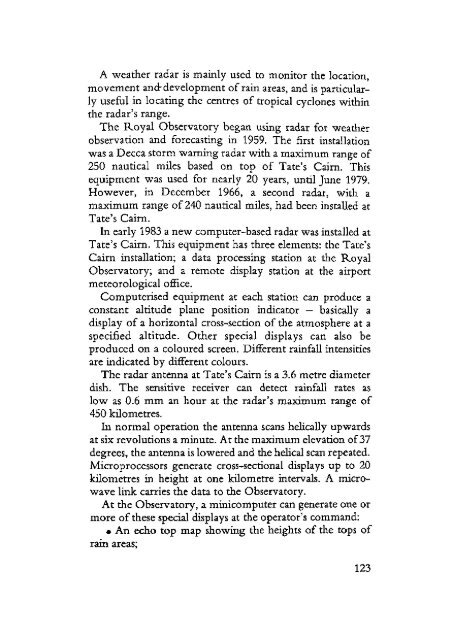Royal - HKU Libraries - The University of Hong Kong
Royal - HKU Libraries - The University of Hong Kong
Royal - HKU Libraries - The University of Hong Kong
You also want an ePaper? Increase the reach of your titles
YUMPU automatically turns print PDFs into web optimized ePapers that Google loves.
A weather radar is mainly used to monitor the location,movement and-development <strong>of</strong> rain areas, and is particularlyuseful in locating the centres <strong>of</strong> tropical cyclones withinthe radar's range.<strong>The</strong> <strong>Royal</strong> Observatory began using radar for weatherobservation and forecasting in 1959. <strong>The</strong> first installationwas a Decca storm warning radar with a maximum range <strong>of</strong>250 nautical miles based on top <strong>of</strong> Tate's Cairn. Thisequipment was used for nearly 20 years, until June 1979.However, in December 1966, a second radar, with amaximum range <strong>of</strong> 240 nautical miles, had been installed atTate's Cairn.In early 1983 a new computer-based radar was installed atTate's Cairn. This equipment has three elements: the Tate'sCairn installation; a data processing station at the <strong>Royal</strong>Observatory; and a remote display station at the airportmeteorological <strong>of</strong>fice.Computerised equipment at each station can produce aconstant altitude plane position indicator — basically adisplay <strong>of</strong> a horizontal cross-section <strong>of</strong> the atmosphere at aspecified altitude. Other special displays can also beproduced on a coloured screen. Different rainfall intensitiesare indicated by different colours.<strong>The</strong> radar antenna at Tate's Cairn is a 3.6 metre diameterdish. <strong>The</strong> sensitive receiver can detect rainfall rates aslow as 0.6 mm an hour at the radar's maximum range <strong>of</strong>450 kilometres.In normal operation the antenna scans helically upwardsat six revolutions a minute. At the maximum elevation <strong>of</strong> 37degrees, the antenna is lowered and the helical scan repeated.Microprocessors generate cross-sectional displays up to 20kilometres in height at one kilometre intervals. A microwavelink carries the data to the Observatory.At the Observatory, a minicomputer can generate one ormore <strong>of</strong> these special displays at the operator's command:• An echo top map showing the heights <strong>of</strong> the tops <strong>of</strong>rain areas;123
















